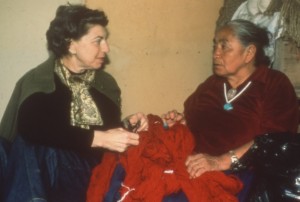TUCSON, AZ (July 8, 2013) — Like never before, two brand new searchable and illustrated databases aim to share the artistry and study of southwestern textiles through the worldwide web.
The two databases plus extensive background information and helpful guides are available on the ASM website at: http://www.statemuseum.arizona.edu/coll/textile/asm_southwest_textile_database/
http://www.statemuseum.arizona.edu/coll/textile/jbw_southwest_textile_database/
Available at the click of a mouse are baseline data and images essential for understanding the evolution of three cultural textile traditions in the American Southwest—Navajo, Pueblo, and Spanish American. Focusing on the nineteenth and early twentieth centuries, their history spans three major periods from the time of Spanish governance to 1821, the Mexican era until 1846, and the American and early reservation period since then. These groundbreaking resources represent the culmination of decades of research by two world-renowned textile authorities: the late Dr. Joe Ben Wheat of the University of Colorado at Boulder and Dr. Ann Lane Hedlund, who recently retired as curator at Arizona State Museum and professor of anthropology at the University of Arizona. Of this capstone project, Hedlund says
These tools can be used by anyone to create absolutely new knowledge about the Southwest’s Native American and European-influenced textile traditions. Most importantly, as an anthropologist who studies both living and long past artists, I want artists of all stripes to have access to this wondrous visual and technical compilation.”
Other audiences that Hedlund lists include every museum curator with SW textiles in their collections; scholars interested in SW history and material culture; handweavers and artists seeking the roots of SW weaving; collectors and others who appreciate worldwide crafts, folk art, and art of all time. “And certainly students of all ages, I hope students will enjoy exploring the information and will get it to tell us things that we’ve never known before.”
Though other online databases of museum collections exist, and there are certainly in-depth databases of ceramics and other media, there is nothing quite like these two new textile resources in terms of their detail and query-based interactivity.
It’s also a first to have such stellar visual, technical, historical selections from so many museum collections gathered in one place for comparisons,” says Hedlund. “I know of nothing that allows visitors as much access and ability to query the data as this incredible store of information does. We included nearly every SW textile in our collections, some 600 examples, and just over 1300 specimens studied by Wheat in 50 other public collections.”
Joe Ben Wheat was one of the first two recipients of a PhD in anthropology at the University of Arizona. He is the author of Blanket Weaving in the Southwest, which Hedlund edited and posthumously published in 2003. Ann Hedlund’s books include Reflections of the Weaver’s World, Navajo Weaving in the Late 20th Century, Navajo Weavings from the Andy Williams Collection, and Gloria F. Ross & Modern Tapestry. She also is curator of many textile exhibits and has presented countless public lectures around the world. The online databases were engineered by ASM Webmaster Laura LePere and Applications Programmer Michael Ornelas, with contributions by David Hayden of Museum Data Solutions and many other valuable participants who are acknowledged on each website.



